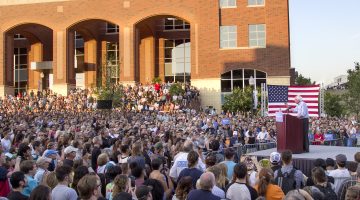The 2016 presidential election is making history in more ways than one. This is the first time a woman has claimed a major party nomination for president of the United States, the first time since Dwight D. Eisenhower that a person without experience in a government role or Congress has been nominated and both candidates are the oldest in history.
The differences in this year’s election compared to past election make it obvious that educating students on elections is a lot trickier than it used to be. The question of how the elections will affect education today and in the future — both in public and higher-education institutions — is significant.
The key to understanding how education is affected is understanding specifically how this year’s election differs from the norm, said Jennifer Ring, a political science professor at the University of Nevada, Reno, who specializes in race and gender in American politics.
Race and gender have both played a very large role in this election compared to previous years, Ring said.
“Donald Trump has enabled haters in this country to think they’re being real, rather than politically correct, by being racists,” Ring said.
According to Ring, there has been an escalation of racial tension in the country that has not been seen in previous elections.
Kevin Banda, an assistant professor of political science at UNR, said before the 2008 election, racial attitudes and anxieties in the U.S. didn’t predict votes, but from 2008 to now race plays a powerful role in elections.
“People have now been primed to use their racial attitudes to make political assessments in ways that they haven’t been for a long time,” Banda said.
Gender and gender attitudes have also played a big role in this election compared to previous elections, Banda said.
According to Ring, this is in part because of Hillary Clinton being the first woman nominee. However, the extreme symbolism behind potentially having a female as commander in chief has been lessened because of the antics between the two candidates and the controversy surrounding Clinton.
Ring stated Donald Trump’s language involving women and the recent accusations of sexual assault have also brought gender into the limelight, and not in a positive way.
The hateful rhetoric and language between Hillary Clinton and Donald Trump have enhanced the polarization of the country, and this causes teachers and professors to take note.
This year many public school teachers are choosing to focus not on the candidates but on the election process and the ideologies of the different parties.
In a survey this year conducted by Teaching Tolerance, a division of the Southern Poverty Law Center, from March 31 to April 2, nearly 2,000 teachers were questioned about the impact of this year’s election on students and schools. More than 40 percent of the teachers surveyed were hesitant to teach about the election at all.
Ring argues not teaching the election or attempting to “clean up” the election harms students and avoids important dialogues that simply can’t be ignored.
“The tendency of primary and secondary education is to give the least disturbing story,” Ring said.
She worries that problems of economic polarization, race and other difficult but important topics aren’t being discussed as much as they should be.
Ring teaches a course at UNR called Identity Politics that is dedicated to correcting everything incoming college students learned in primary and secondary schools. Ranging from topics of racial tension within the U.S. to problems revolving around religion, gender and class, Identity Politics often surprises and angers students because they didn’t learn correct information in high school, Ring said.
Banda agrees with Ring that politics cannot be ignored in our primary and secondary schools, but he argues instead of focusing on the messiest parts of the campaigns, educating students on the basics of politics and governments in both the U.S. and other countries is important.
“There are holes in secondary and primary [education]. Even if they aren’t taught poorly, they aren’t taught very broadly,” Banda said. “I think that the civics class that is taught in most places is pretty useless … it would be useful, I think, for high schoolers to have at least a semesterlong course on how government actually works, both in terms of how it should work and how it does work.”
However, Banda said he does not have a lot of trust in our public schools to give the students the information they need without American-centric language, such as “America is the greatest and can’t be beat.”
Higher-education institutions are where most students get correct, meaningful information that stems from free-flowing discussions and few topic boundaries, but unfortunately the people who don’t get the chance to attend a college or university are left with the very basic — and mostly false — information public schools give them, Banda said.
While it may be difficult to determine how this year’s election should be covered in schools, educators like Banda and Ring agree it can’t be ignored.
Teaching Tolerance, shortly after its survey of educators, developed tips for teachers on how to educate students about this year’s election. The tips include protecting marginalized students by barring name-calling and setting ground rules, staying narrow in teaching objectives and encouraging media literacy by helping students fact-check what they hear.
The 2016 presidential elections are far from the normal democratic process we all know and have learned about, Banda said. In terms of higher education, this is the first election a lot of Banda’s students have really paid attention to.
“This is such a weird time to come of age politically,” Banda said.
Whichever way the election ends, our country’s education on politics, now and in the future, is forever changed because of the tumultuous journey that is the 2016 presidential election.












